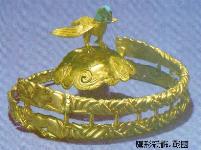 |
A golden crown with spiral headband, from the area of
Xiongnu 匈奴 people. The motives of the band are not
influenced by Chinese art but remind of the Thracian
goldsmith's art. The eagle's head is made of turquois. |
 |
This pair of eardrops are also from the Xiongnu area
in Inner Mongolia. The left piece has a pendant turquois
stone. |
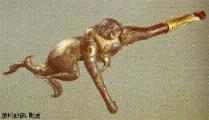 |
This piece of jewelry with the shape of a monkey from
the Warring States period 戰國 was found in Shandong. The core
is made of silver and partially covered with gold. Small
blue stones are inlaid in the animal's eye sockets. |
 |
This vessel called zhan 盞
was dug out of the Warring States tomb of Marquis Zeng 曾侯 in Hubei. The filagree spoon is a
hint that this bowl of solid gold (weight 2150 g,
diameter 15 cm) has not been used for liquids. |
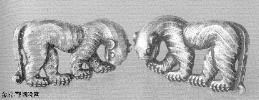 |
Slim and gender is this pair of silver tigers from
the Warring States period. |
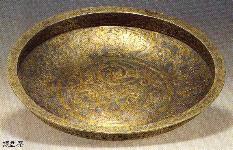 |
Silver dish from the Qin Dynasty 秦 (diameter 37 cm)
with fine gold inserts. The pattern reminds of the lions
in Nordic art. |
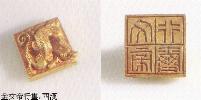 |
Gold seal of Han Dynasty emperor Wendi 漢文帝 (height ca. 2 cm). The inscription says, "Executive
seal of Wendi" 文帝行璽. |
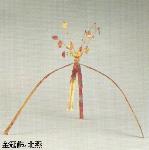 |
Head ornament from the Northern Dynasties 北朝 (actually: Northern Yan 北燕). This kind
of ornament with the always moving small spangles was
popular until the 20th century, in most cases as a
hairpin. The example to the left looks more like a crown. |
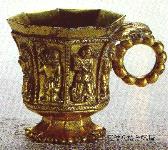 |
The influence of Central Asian and Near Eastern art
can be seen in this embossed gold cup from the Tang
Dynasty 唐. It is decorated with eight persons, musicians
and dancers. |
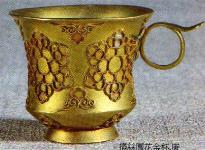 |
Less crude and with applied filigree ornaments and
pearls, an other Tang Dynasty cup. |
 |
This wunderfully cast and slightly embossed dragons of
red gold were made during the Tang Dynasty (height only 2-3
cm). Every single piece shows a different movement. |
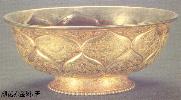 |
Embossed gold bowl from the Tang Dynasty. The pattern
has the shape of lotus petals, showing the influence of
Buddhism also in decorating handicraft items. |
 |
A miniature shrine with precious stones inlaid in the
base and upon the roof, the body made of gold, silver and
bronze during the Tang Dynasty. |
 |
This golden chased dish from the Tang Dynasty shows
dragons and fish coming out of the surface (47 cm
diameter). |
 |
A spangled hair pin from the Tang Dynasty. Compared
to the piece from the Northern Dynasties, it shows a
development in refining. |
 |
A tortoise made of silver and fine gold upon whose back
a metal candleholder is mounted. The candle's upper part
is formed like a real candle with a flame and can be
taken off to put in a real candle. A tasteful example of
Tang time goldsmith's art (34 cm tall). It resembles some
stone pillars in the famous "stele forests"
that are found everywhere in China. |
 |
This silver cup from the Tang Dynasty shows scenes of
dancing and hunting on its eight areas. |
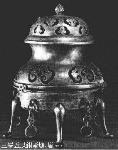 |
A silver incense burner from the Tang Dynasty. |
 |
Dali 大理 was a realm in the modern province of Yunnan.
Its art has much common with that of its southern
neighbors Laos and Birma. This silver core gilded
specimen is a picture of the Hindu mythical bird Garuda.
The flames behind the bird are ornamented with five rock
crystals (18 cm tall). |
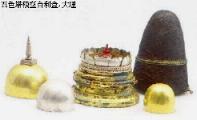 |
Composed of five different metals, this praying set
from Dali copies the shape of a buddhist stupa or mynah (shelita 舍利塔) and can be
taken away as a pocket altar. |
 |
The influence of Islamic art can be seen in this dish
from the Song Dynasty 宋 (diameter 17 cm)... |
 |
... while this dish shows the typical Chinese motif of
dragons and fish playing in the water. |
 |
A Song Dynasty silver case, made of woven wires (yinsi 銀絲). |
 |
The producer of this bowl from the Song Dynasty decorated with pearls used
the old nipple-nail pattern to decorate his work. |
 |
The Khitan people that founded the Liao Dynasty 遼 had
much contact to the Central Asian islamic people and
adopted their style in the art, like in this silver pot. |
 |
A very crude silver hairpin from the Yuan Dynasty 元. |
 |
A typical feature of many Chinese daily used
handicraft is the box-in-the-box principle like this
beautiful set of big and small silver boxes from the Yuan
Dynasty. |
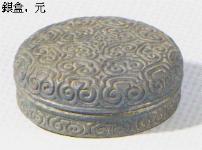 |
From Song times on, this new pattern of intertwined
clouds, waves or dragon bodies became very popular, especially used to decorate
boxes like this round Yuan dynasty box. |
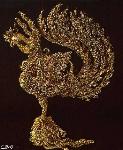 |
Highest perfection of goldsmith's art: a very
filigree hairpin from the Ming Dynasty 明 (22 cm long). |
 |
The upper part of this golden hairpin from the Ming
Dynasty is shaped like a leaf and inlaid with precious
stones. |
 |
Like many items of Ming and Qing art, this golden jue 爵 vessel on a dish is very overloaded
with precious stones. |
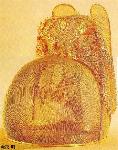 |
A Ming empress was the owner of this gaze-like crown,
made of gold wires (24 cm tall). |
 |
The feet of this armillary sphere (celestial globe)
are made from intertwined gold dragons, the base is
partially made of cloisonné, and more than 3000
black and white pearls shape the particular
constellations inside the golden heaven of this
spectacular piece of Qing 清 emperor patronage (height 30 cm). |
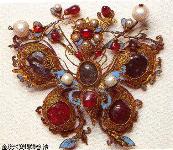 |
The wings of this Qing butterfly-shaped brooch are
composed of different precious stones. |
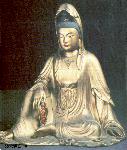 |
A statue of the meditating Guanyin 觀音 Bodhisattva,
cast in gold and holding a wooden rosary in his/her hand. |
 |
Hairpins inlaid with different stones from the Qing
Dynasty. |
 |
This wonderful combination of a bowl on a high stand
is made of two different materials. Stand and cover are
made of gold, the bowl itself of jade. Cut turquois
stones are inlaid in cover and stand. The inner surface
of the bowl is engraved with a text in Tibetian. This
shows the presence of Tibetian monks and diplomats at the
Qing court in Beijing. |
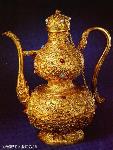 |
Chinese art oftenly uses the shape of the gourd, in
most cases for chinaware vases and here, for a pot with
handle. The golden chased pot from the Qing Dynasty is
inlaid with precious stones. |
 |
In old China, religion was never a matter of wars
like in Europe. Ancestor worship, Buddhism, Daoism,
Christianity and Islam could exist side by side and were
respected at the Qing court. Qing goldsmiths created this two floor
gold wire pagoda with a Buddha image inside (23 cm tall) |
 |
A penjing 盆景, a
kind of bonsai-like landscape in a pot. In most cases,
this landscapes are made of stone like jade or soapstone
and have the shape of a mountain. This penjing
is a palm tree, minutiously chased of gold filagree. |
 |
A ruyi 如意 scepter
of solid gold. The scepter in China had not the same
meaning like in Europe where it was exclusively used by
the sovereign. Originally it could have been a note table
of bamboo for the ministers that they held respectfully
in their hands in front of the breast during an audience,
like the gui 圭. In later times, it was made of each
possible material but mostly of jade, a stone that
symbolizes longevity. The shape of the scepter is taken
from a kind of mythological mushroom that was said to
give eternal life. In Qing times, the ruyi
scepter was used by princes and the Emperor as a symbol
of their position. |
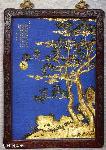 |
A poem, the fullmoon and an osmanthus constituate
this wonderful composition of a night sky picture. Leaves
and flowers are equally detailed like the grass and the
stones on the ground (heigt 163 cm). |
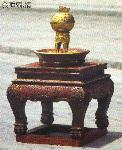 |
A golden spittoon on a small table from the old
palace in Peking. |
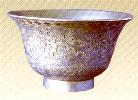 |
This embossed silver bowl was made in Yunnan. |
 |
Dozens of silver wires (yin leisi 銀纍絲) unite to petals that are bound
together in the upper part, thus shaping a flower vase (17
cm tall). |